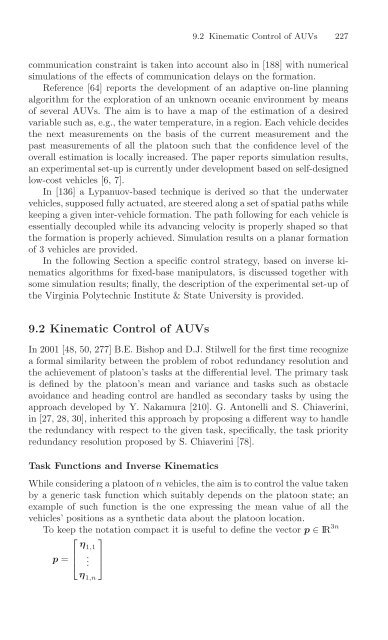Underwater Robots - Gianluca Antonelli.pdf
Underwater Robots - Gianluca Antonelli.pdf
Underwater Robots - Gianluca Antonelli.pdf
You also want an ePaper? Increase the reach of your titles
YUMPU automatically turns print PDFs into web optimized ePapers that Google loves.
9.2 Kinematic Control of AUVs 227<br />
communication constraint istaken into account also in[188] with numerical<br />
simulations of the effects of communication delays on the formation.<br />
Reference [64] reports the development ofanadaptive on-line planning<br />
algorithm for the exploration of an unknown oceanic environment bymeans<br />
of several AUVs. The aim is to have amap of the estimation ofadesired<br />
variable such as, e.g., the water temperature, in aregion. Each vehicle decides<br />
the next measurements on the basis of the current measurement and the<br />
past measurements of all the platoon such that the confidence level of the<br />
overall estimation is locally increased. The paper reports simulation results,<br />
an experimental set-up is currently under development based onself-designed<br />
low-cost vehicles [6, 7].<br />
In [136] aLypanuov-based technique is derived so that the underwater<br />
vehicles, supposedfullyactuated, are steered along aset of spatial paths while<br />
keeping agiven inter-vehicle formation. The path following for each vehicle is<br />
essentially decoupled while its advancing velocity isproperly shaped sothat<br />
the formation is properly achieved. Simulation results on aplanar formation<br />
of 3vehicles are provided.<br />
In the following Section aspecific control strategy, based oninverse kinematics<br />
algorithms for fixed-base manipulators, is discussed together with<br />
some simulation results; finally, the description of the experimental set-up of<br />
the Virginia Polytechnic Institute &State University isprovided.<br />
9.2 Kinematic Control of AUVs<br />
In 2001 [48, 50, 277] B.E. Bishop and D.J. Stilwell for the first time recognize<br />
aformal similarity between the problem of robot redundancy resolution and<br />
the achievement ofplatoon’s tasks at the differential level. The primary task<br />
is defined by the platoon’s mean and variance and tasks such asobstacle<br />
avoidance and heading control are handled assecondary tasks by using the<br />
approach developed by Y. Nakamura [210]. G. <strong>Antonelli</strong> and S.Chiaverini,<br />
in [27, 28, 30], inherited this approach byproposing adifferent way to handle<br />
the redundancy with respect to the given task, specifically, the task priority<br />
redundancy resolution proposed by S. Chiaverini [78].<br />
Task Functions and Inverse Kinematics<br />
While considering aplatoon of n vehicles, the aim is to control thevaluetaken<br />
by ageneric task function which suitably depends on the platoon state; an<br />
example of such function isthe one expressing the mean value of all the<br />
vehicles’ positions as asynthetic data about the platoon location.<br />
3 n<br />
To keep the notation compact it is useful to define the vector p ∈ IR<br />
p =<br />
⎡<br />
⎢<br />
⎣<br />
η 1 , 1<br />
.<br />
.<br />
η 1 ,n<br />
⎤<br />
⎥<br />
⎦






